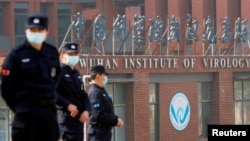President Donald Trump's efforts to dismantle the United States Agency for International Development, or USAID, have brought the agency’s global pandemic response efforts into the spotlight.
That includes USAID’s role in funding research at China’s Wuhan Institute of Virology, or WIV, where the Central Intelligence Agency and others believe SARS‑CoV‑2, a strain of coronavirus that causes COVID-19, “most likely originated."
Beijing, which has both maintained that SARS‑CoV‑2 arose naturally while also spreading conspiracy theories that a U.S. army lab was the actual source of the pandemic, continues to deflect from criticism the virus may have originated in a Chinese laboratory.
On Feb. 12, China’s Foreign Ministry spokesperson, Guo Jiakun, was asked about U.S. media reports that USAID had funded gain-of-function studies at the WIV.
Guo denied China had conducted such research.
“China has also made it clear more than once that the Wuhan Institute of Virology has never engaged in gain-of-function studies of coronavirus. Never has it designed, made or leaked COVID-19. On the origins-tracing of the virus, China firmly opposes all forms of political manipulation.”
That is misleading.
Various investigative reports leave no question that scientists at the Wuhan Institute of Virology have manipulated coronaviruses. The issue is whether the types of manipulation being carried out at the Wuhan lab are considered gain-of-function under differing bureaucratic and scientific guidelines.
Changes or enhancements of viruses that scientists consider gain of function include altering viral pathogenesis (how a disease develops in its host); host range (the types of hosts that a microorganism can infect); transmissibility (a pathogen's capacity to pass from one organism to another); and virulence (a virus’ ability to cause damage to a host).
The U.S. National Institutes of Health, or NIH, gave $3.7 million to USAID-funded EcoHealth Alliance for research centered on “understanding the risk of bat coronavirus emergence.”
EcoHealth Alliance is a U.S.-based organization “that conducts research and outreach programs on global health, conservation and international development.”
EcoHealth Alliance used $600,000 of that funding to research coronaviruses at the WIV, which had “isolated some 300 bat coronavirus sequences,” according to a 2017 article in the journal Nature.
In 2021, the National Institute of Allergy and Infectious Diseases, or NIAID, told VOA in a written comment that none of the studies it “supported indirectly” at the WIV “under a sub-award from EcoHealth Alliance” constituted gain-of-function research, as those studies were not designed to manipulate viruses to increase their transmissibility or ability to cause disease.
But NIAID said that the grant it provided EcoHealth Alliance funded research that entailed creating chimeric (human-made) viruses.
That research, NIAID said, involved researchers “placing a small portion of newly identified, evolutionarily distant, bat coronaviruses into another well characterized bat coronavirus that has never been demonstrated to infect humans called WIV1.”
A 2017 study by WIV scientists, titled, “Discovery of a rich gene pool of bat SARS-related coronaviruses provides new insights into the origin of SARS coronavirus,” noted the use of “chimeric" or human-made viruses in studying how two SARS-CoV viruses were able to infect and replicate in human cells.
Another 2015 study, where research was primarily conducted at the WIV, said, “We generated and characterized a chimeric virus expressing the spike of bat coronavirus SHC014 in a mouse-adapted SARS-CoV backbone.”
The former president of EcoHealth Alliance, Peter Daszak, also described his colleagues conducting research of this nature in China.
“Then when you get a sequence of a virus, and it looks like a relative of a known nasty pathogen, just like we did with SARS, we found other coronaviruses in bats, a whole host of them, some of them looked very similar to SARS. So we [genetically] sequenced the spike protein — the protein that attaches to cells,” Daszak said in February 2016.
Daszak continued: “Then we, well I didn’t do this work, but my colleagues in China did the work, you create pseudo particles, you insert the spike proteins from those viruses, see if they bind to human cells. At each step of this you move closer and closer to this virus - could really become pathogenic in people. So you narrow down the field, you reduce the cost, and you end up with small number of viruses that really do it like killers.”
Dr. Richard Ebright, a professor of chemistry and chemical biology at Rutgers University and biosafety expert, told the National Review in May 2021 such studies “epitomize” gain-of-function research.
Daszak was also a member of the World Health Organization’s fact-finding mission to Wuhan in January and February 2021. He was instrumental in leading efforts to paint the lab-leak hypothesis as a conspiracy theory.
On Jan. 17, the Department of Health and Human Services, or HHS, cut off funding and formally debarred EcoHealth Alliance and Daszak for five years over their involvement in virus research in Wuhan.
According to the House of Representatives’ Committee on Oversight and Government Reform, the HHS found that EcoHealth and Daszak “facilitated gain-of-function research in Wuhan, China without proper oversight and willingly violated multiple requirements of its multimillion-dollar National Institutes of Health (NIH) grant.”








